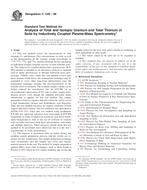Wir benötigen Ihre Einwilligung zur Verwendung der einzelnen Daten, damit Sie unter anderem Informationen zu Ihren Interessen einsehen können. Klicken Sie auf "OK", um Ihre Zustimmung zu erteilen.
ASTM C1345-08
Standard Test Method for Analysis of Total and Isotopic Uranium and Total Thorium in Soils by Inductively Coupled Plasma-Mass Spectrometry (Withdrawn 2015)
Automatische name übersetzung:
Standard Test Method for Analyse des Gesamt und Isotopen Uran und Thorium Gesamt in Böden durch induktiv gekoppelte Plasma-Massenspektrometrie
NORM herausgegeben am 1.1.2008
Informationen über die Norm:
Bezeichnung normen: ASTM C1345-08
Anmerkung: UNGÜLTIG
Ausgabedatum normen: 1.1.2008
SKU: NS-10779
Zahl der Seiten: 12
Gewicht ca.: 36 g (0.08 Pfund)
Land: Amerikanische technische Norm
Kategorie: Technische Normen ASTM
Die Annotation des Normtextes ASTM C1345-08 :
Keywords:
inductively coupled plasma-mass spectrometry (ICP-MS), isotopic ratio, soil, thorium, uranium, ICP-MS (inductively-coupled plasma-mass spectrometry), Isotopic analysis, Soil (radioactive analysis), Thorium, Uranium content, ICS Number Code 13.080.10 (Chemical characteristics of soil)
Ergänzende Informationen
| Significance and Use | ||||||||||||||||||||||||||||||||||||||
|
This test method measures the presence of uranium and thorium in soil that occurs naturally and as a result of contamination from nuclear operations and uranium ore processing. The reporting detection levels (RDLs) of total uranium and thorium are well below the normal background in soil. The normal background level for uranium is between 3 and 5 μg/g in most geographic areas and slightly higher for thorium. The 235U enrichment is also measured from an initial sample pass through the instrument. The other less abundant uranium isotopes (234U and 236U) are measured down to a typical soil background level after sample concentration and a second sample analysis. This allows for calculation of individual isotopic uranium and total uranium activity. The majority of the uranium activity results from 234U and 238U. |
||||||||||||||||||||||||||||||||||||||
| 1. Scope | ||||||||||||||||||||||||||||||||||||||
|
1.1 This test method covers the measurement of total uranium (U) and thorium (Th) concentrations in soils, as well as the determination of the isotopic weight percentages of 234U, 235U, 236U, and 238U, thereby allowing for the calculation of individual isotopic uranium activity or total uranium activity. This inductively coupled plasma-mass spectroscopy (ICP-MS) method is intended as an alternative analysis to methods such as alpha spectroscopy or thermal ionization mass spectroscopy (TIMS). Also, while this test method covers only those isotopes listed above, the instrumental technique may be expanded to cover other long-lived radioisotopes since the preparation technique includes the preconcentration of the actinide series of elements. The resultant sample volume can be further reduced for introduction into the ICP-MS via an electrothermal vaporization (ETV) unit or other sample introduction device, even though the standard peristaltic pump introduction is applied for this test method. The sample preparation removes organics and silica from the soil by use of a high temperature furnace and hydrofluoric acid digestion. Thus, this test method can allow for sample variability of both organic and silica content. This test method is also described in ASTM STP 1291. Since this test method using quadrupole ICP-MS was approved, advances have been made in ICP-MS technology in terms of improved sensitivity and lower instrument background as well as the use of collision or reaction cells (or both) and sector field mass spectrometers with single and multiple detectors. These advances should allow this test method to be performed more effectively but it is the user’s responsibility to verify performance. 1.2 The analysis is performed after an initial drying and grinding sample preparation process, and the results are reported on a dry weight basis. The sample preparation technique used incorporates into the sample any rocks and organic material present in the soil. The method of sample preparation applied differs from other techniques, such as those found in Practice C 999, which involve simply tumbling and sieving the sample; however, the user may select whichever technique is most appropriate to their needs. 1.3 The values stated in SI units are to be regarded as standard. 1.4 This standard does not purport to address all of the safety concerns, if any, associated with its use. It is the responsibility of the user of this standard to establish appropriate safety and health practices and determine the applicability of regulatory limitations prior to use. |
||||||||||||||||||||||||||||||||||||||
| 2. Referenced Documents | ||||||||||||||||||||||||||||||||||||||
|
Empfehlungen:
Aktualisierung der technischen Normen
Wollen Sie sich sicher sein, dass Sie nur die gültigen technischen Normen verwenden?
Wir bieten Ihnen eine Lösung, die Ihnen eine Monatsübersicht über die Aktualität der von Ihnen angewandten Normen sicher stellt.
Brauchen Sie mehr Informationen? Sehen Sie sich diese Seite an.




 Cookies
Cookies
